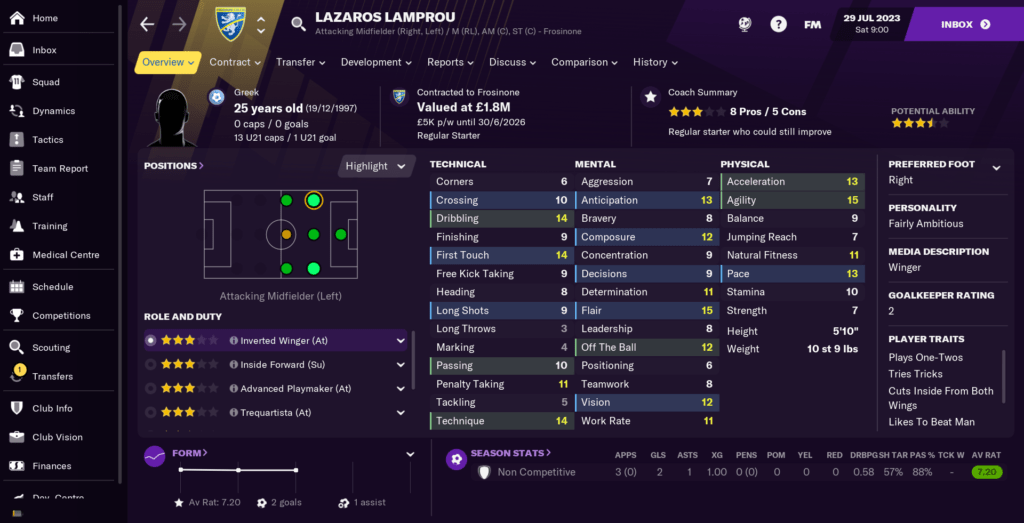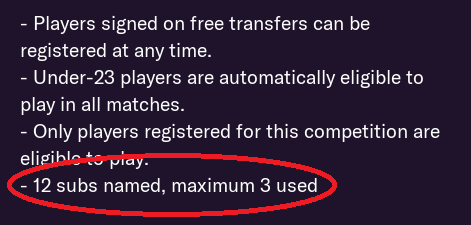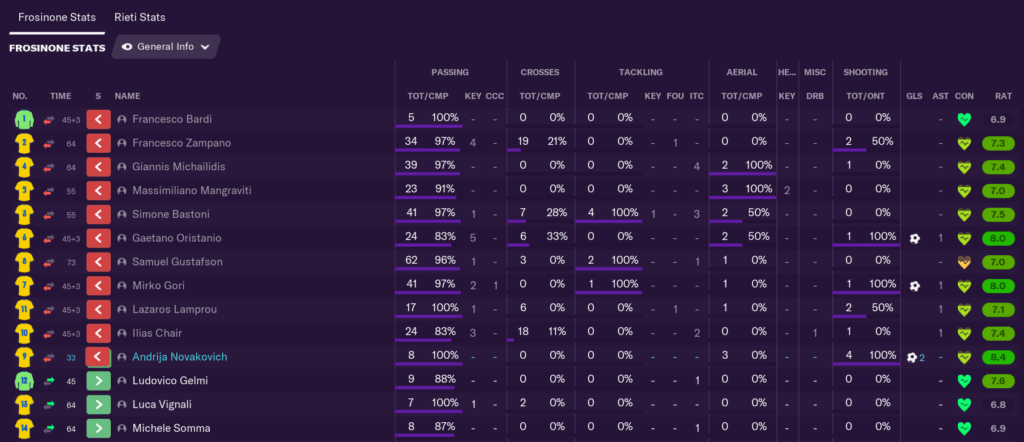
Mastering Substitutions | A Guide To Utilising Your Bench During A Game
Did you know that the players sat with you in the dugout can be just as useful as your Starting XI? I’m sure you did – but are you using them to your full advantage? Friendlies, Cups, League games. Every game you play needs a strategy and this also extends to the bench. In this article I’m going to use the five W’s show you the key to mastering substitutions.
The Basics
So I suppose the first thing to ask is why we’d bother with subs. In real-life, I watch a lot of live games and different managers have a different ethos. John Askey, former Macclesfield Town gaffer, is a great manager but one of the main things I used to notice about him whilst following the Silkmen was that he didn’t often use his subs. Most of the time, he’d only turn to it if injuries occurred. In fairness to him though, this was probably due to the lack of players at the club at the time. Hard to make subs with confidence when you struggle to fill the team sheet.
On a more high-profile note, everybody knows about Claudio “The Tinkerman” Ranieri’s approach to squad rotation. And of course most of you will remember Duncan Ferguson at Everton bringing Moise Kean on as a sub… and then back off again! A bold move indeed – but it goes to show that the possibilities can be almost endless.
The key things to consider are the classic five W’s. Who? What? When? Where? and Why? 1) Who do you want to have populating your bench? Exciting youth prospects and older experienced heads can both be useful. 2) What is your strategy when considering a substitution? It can be so easy to forget to make subs in the heat of the action. 3) When is the best time to get them involved? A half-time triple whammy isn’t always the way. 4) Where in the world are you playing? Different competitions have all sorts of rules about subs. 5) Why are you making subs? Possibly the most important question of all.
Who?
On matchday picking the Starting XI is always an exciting moment, but do you feel the same with your bench. You should! I am a big believer in balance and whether you have a five-person bench or twelve slots to fill, don’t just see your subs as the guys who couldn’t make the first team. A bit of a cliché, but it is so true that these days we must play a “squad game.” There is a reason why the big clubs have huge squads and whilst you may know your Starting XI off by heart, the subs need thought too.
My main plan of action when it comes to who is having the ability to replace any injured player with a natural fit. Easier said than done in the lower leagues, but in any career it is possible. Since starting my FM21 save at Christmas, I have managed three teams. Stafford Rangers in non-league, Dungannon Swifts in Northern Ireland and now Frosinone in Serie B, Italy. Each team naturally brings different strategy.
Cover Your Positions
At Stafford, I could only afford around twenty players at a time, so by the time I had a Starting XI, it’s a case of picking seven subs from my remaining nine players. A lot of praying that injuries don’t occur also came into play. Joking aside though, I would always try to have my seven subs available to do a job where needed and to be able to cover all positions in the case of injury. There’s no point having two strikers on a bench of seven, if you only play with one or two strikers. Right-backs who can play right-wing – great. Centre-backs who can also jump into left-back – amazing. A winger who can jump on to either side – sublime! Of course, some shuffling of the Starting XI may also need to be considered.
I know that keepers on the bench is always a controversial topic, but my rule is that if I have more than five spaces on a bench then I may as well take one. I think that in over ten years I’ve had two instances of a keeper needing to be replaced, but you never know.

Age vs Experience
Whilst at Dungannon Swifts I had a bit more choice – and a youth team! This gave me the chance to do more than just fill the bench, but make it into a weapon I can use to my advantage. Most of my subs at the Swifts were exciting youth prospects, but I also packed an old-head centre-back for when the going got tough. It often did. And more to the point, it’s also worth thinking about those players who are your classic “super subs”. I had a young winger called Gareth Surgeon who always seemed to come on and make the difference. However, whenever I gave him a start he just did not impress.
In fact I had such luxury in depth that I could even start to think about having defensive and attacking minded subs. If I was winning, there was always the option to chuck the veteran ball winning midfielder on. When things weren’t going to plan, I’d often stick a pacey winger on to refresh my attacking options. Either way, you can only make an impact if you have the players at your disposal.
Fine-Tuning
Now that I am at a full-time club in Frosinone, the strategy develops even more. In fact, it’s actually harder now because the choices are so vast. Do I put my young Estonian poacher on there as a different option to my big starting target man? Should I persist with the club stalwart who has experience in the top level of Italian football? The answer isn’t as simple as one of the other, but more about who you are facing. And in this instance I would always do a bit of manual scouting of the opponents to get the facts. My young poacher is definitely the better player, but with a strength rating of just 3 he will ultimately struggle against the bigger defenders. Trotta, my older head, is a big unit so may be more favourable when we need to dig in and get physical.
Another thing to note is that there are some players which may not be your best, but have brilliant versatility. One of my first signings of the summer in Italy was Lazaros Lamprou and the kid can comfortably take on four of the eleven spaces my team plays. In pre-season, I am intending to play him as a RAM, CAM, LAM and even up top to see what he can do. So far he’s got two goals and an assist in his first three starts. Does that mean he should move to the Starting XI? Not necessarily. A great lad to have in a sticky situation, though.

What?
Of all of the questions this one is the most open-ended as it really does come down to personal preference. My approach to what strategy to use is to be methodical and have certain times in mind to make my subs regardless of how the game is going. The other option is to be reactionary. “Oh no, we’ve conceded. Let’s sling another striker on!” isn’t necessarily the wrong way to do things, but it’s just not the way I like to roll. I much prefer to think that usually around the hour mark in a match is when things start to slow down. Sometimes I’ll be cruising, other times I am 0-3 down. It may even be a tense 1-1.
Method in the Madness
What I think is important above all is to treat your sub bench as a lifeline rather than a chore. I know some players who use terms like “I suppose I better make some subs” or sometimes even just forget. It’s such an old-fashioned thing to assume that the subs are the players who aren’t good enough to start and therefore aren’t worth using unless needed. I spend just as much time thinking about what they can do for me as the Starting XI. Some players may think that is madness and that the bench is just a tool for refreshing the team, but not me.
When?
It may seem a bit silly or appear to be a method of overthinking to always make subs around the hour mark, but bear with me. With a win almost guaranteed at that point, I love the chance to stick some of the less regular players on. Equally, when losing I like to see the last thirty minutes as my chance to claw something back. When drawing, it often tends to be more about sticking or twisting. If I’m holding on for the point in a league game. I sometimes shut-up shop. When the game is there for the taking, I will use my bench to freshen up the tired areas and make tactical adaptations.
Scenario Planning
Providing I am in a classic “three subs allowed” situation as many leagues and cups tend to be, I will often use a couple of my subs between the 55th and 70th minute. A top tip though is to always leave one available unless desperate. My final sub tends to be around the 75th minute and it really can vary in terms of what I do. It could be a last roll of a dice, it may be a late run out for a player looking for a landmark appearance. Heck, sometimes it is the lad who scores an injury-time winner to make you feel like a young Sir Alex! The below image shows one of my mastermind victories. An away 3-0 win against the League Champs. Note my 16-year old winger coming on to get a goal and an assist!

Where?
Some competitions allow five subs out of nine from the bench. Others will have as many as twelve sub places and six can be used. Traditionally, many have three subs available out of seven. Whatever the case is, make sure you know the rules based on where you are playing. I am currently in the middle of an experimental save in Scotland and in League Two I can make as many as five subs, providing play isn’t stopped more than three times. This is the first time I’ve come across this rule. In Australia in the early 2010’s, the A-League would only allow you to name four subs and you were obliged to name a goalie. Tough going!
Know the Rules
If you are playing in a domestic league, cups and continental competitions, it can be easy to forget what’s going on, so make sure you take a moment to know what the rules are. This will help you decide what your strategy is, who to pick and when to use them. The five questions are all linked, believe it or not.

Why?
The last of the five W’s. By now, you should have an idea of who you intend to select for the bench. Hopefully you have considered what your substituting philosophy is. Go into the game thinking about when you might start to use your subs. And don’t forget to check the rules based on where you are playing. The thing that we still don’t know, though, is why?
Personnel Changes
Traditionally, fans will always call for the gaffer to make subs based on poor performance. Even in FM press conferences you’ll get the odd question about why you refused to bring your striker off as he stumbles over the line to a 5.8 match rating.
Truth of the matter is, if someone is playing poorly then it might be worth bringing them off. However, be wary about this method. It is easy to haul off a striker who misses a sitter, but he could score the winner moments later. Unless you bring him off, of course. Equally, it is often tempting to rotate your central midfielders without thinking about why. Is there any point bringing one ball winning midfielder off for another? Does the game warrant you bringing on the same type of player in the form of a new man? Sometimes it does- but don’t just be lazy and assume this is the way to use the bench.
Tactical Tinkering
I have been guilty of this and suspect many others have. When winning 1-0 but being battered, what do you do? CHANGE TACTICS!!!! I’m not saying this is the wrong way to do it, but you need to put a bit of thought behind it. If you are winning but struggling, what is brining an extra centre-back on for your second striker going to achieve? Yes it may firm up the defence and add more bodies into the mix, but it almost certainly means that if you concede then you won’t have the right team to respond. My suggestion would be to tactical tinker in a positive manner only, when it comes to using a substitute. If you are looking to go more defensive, do it through instructions and tactic changes. If you have an attacking playmaker doing nothing, see if he can sit deep and help weather the storm.
I tend to mainly play a basic 4-4-2 at non-league level and a 4-2-3-1 higher up, but I always make sure my Plan B, C or even G involves my subs. A classic example of this is when I would be winning by a slim margin with Dungannon. Often, I would have 40% or less of the possession. So what I’d do is bring a pacey striker on rather than an extra defender, with the aim of countering for an extra goal. It sounds counterproductive to bring a new striker on when winning by nail-biting margins, but give it a try and you might be surprised.
Refreshing the Team
Again this is a stone-cold classic. We’ve all seen the fatigued winger that went from speed demon to slug man over the course of a game. Most of us wouldn’t even be able to last twenty minutes on the field- me included. I will usually always opt to bring a tired player off rather than a poor performing one. A player who is having an off-day is still, after all, the guy you chose to start the game. So presumably he’s your best option in normal circumstances?
That said, you may just shoot yourself in the foot by trying to force a player to play himself back into form and to persist with the same poorly performing player week in, week out just isn’t the answer. If you genuinely feel as though you have other options, give them a game.
Red Card or Injury
As someone who is methodical I get so frustrated when a player gets injured or sent off. An injury that happens early doors isn’t ideal, but is manageable. I do sometimes get stung by late injuries in games though. As I mentioned earlier, I always leave one sub until around the 75th minute to minimise the chances of going down to ten men. It still happens sometimes though so do keep an eye on your players’ condition. Going back to my earlier point about covering all positions on the bench, this is a classic example of why that’s important.
Of course red cards are a game changer at anytime. A strange fact that I cannot explain about my time playing FM21 is that I haven’t lost a game with ten men yet. I tend to find that all of my red cards have come when winning, so have managed to adapt. But ultimately the red card scenario does mean that you may have to make a quick sub. The classic option is to bin off a striker to rebalance the midfield or defence. If you need to go down to zero strikers, make sure you have a good reason for it.
Putting the Pieces Together
Putting what we now know about using the bench in the right way into practice, I will now end this article by talking through a few specific examples about methods I have developed in my game.
Pre-Season
Do you use all twelve subs in a pre-season friendly? If not, why?! Pre-season is all about experimenting, trying players out and building fitness. You cannot do any of that if you play your preferred Starting XI from the get-go. I will make a point of playing as many friendlies as possible- two per week for as many weeks before the season as I can.
People often ask me why my pre-season takes me so long to play and from this article you’ll now know why. I spend so much time taking players on trial and trying out different tactics and players. The sub bench is so important in this process. My formula for making subs in friendlies is very precise. After naming my Starting XI for the match, I pick a second XI that will essentially end the game. I then pick a “wildcard” twelfth player which is usually a lad I want to try out but don’t necessarily feel will make a big impact.
In the game, no matter the score, I then make exact subs at exact times. I make one sub around the 30th minute. I then make five subs at half-time, meaning that more than 50% of the team is different. Then on the 55th, 65th and 75th minute I make two subs each time. I find that this gives me a good mixture of fitness building for all and also a chance to impress.

Cups
Cup games tend to be about rotation for me in most cases. This means giving some of my usual subs a start, a few youth prospects on the bench, and so on. If your star striker is tired, don’t risk him in a Third Round Mid Ulster Cup game. The bench again is important for making this work.
I tend to always have a couple of big names on the bench in case we are in danger, but I also give first choice to the young guns where possible. The chance you give to the 16-year old winger may well lead to his first goal or assist. That may lead to game time in the league. That may lead to him becoming your new starter as you unexpectedly win the Northern Irish Premier League…

Another thing to remind you all too is to check the rules. Some cups will allow you to make an extra sub during extra-time. Use that to your advantage to bring on a brilliant penalty-taker, or to get your courageous 40-year old central midfielder off the pitch. Use it however you want. Just don’t forget you have it.
League
The way in which I use my subs in a league game has been documented above. To reiterate, it’s all about game management. If you are facing top of the league, it’s always worth packing the bench with tough lads or experienced big game players.
Since FM introduced the tool which allows you to change your setup for the next game only, I have found league games much easier to build momentum in. I have my preferred Starting XI locked in the whole time and unless anyone new comes in or rises from the bench, that is sorted. I then only really have to think about rotation and the subs. Ideal.
Don’t be fooled into thinking that consistency is the key though, because on FM that isn’t always true. There may the odd match where certain scenarios unfold and you have to think again. Red cards and injuries are the obvious two, but other things such as a striker missing a first-half penalty can also make you need to rethink who you bring off and when. The three games in a week spells often throw my substitutions plans off a bit.
Big Games
Whether it is a Cup Final or the last game of a gruelling season, treat big games as a whole separate beast when considering subs. I will always name a sub keeper for a final. I do not live by my usual strategic timings of making subs at certain times for these games as you have to adapt minute-by-minute.
If a player picks up a knock in the 25th minute, consider bringing him off. When your best penalty taker is having a stinker, think about keeping him on until the point where you feel his input in a shootout could be disastrous. Should your best defender get a booking in the latter stages, be wary about how he plays for the next ten minutes. If he seems frustrated still then it may be a saving grace to bring him off. Or, his replacement might lose you the big final! The summary point about this is that it is your game. Do it your way, make subs as you wish… but think about those five W’s.

If you enjoyed this post then follow Pint of Football and Dictate the Game on Twitter. For live FM21 action, check out Pint of Football on Twitch as Tom and Daz do battle in South Africa. Also check out more great FM content on our DTG site.
Liked this article? Here’s others you may enjoy…
- Because No Good Story Starts With A Glass Of Milk
- Total Football Journeyman: Building Effective Partnerships in FM21
- From Kingston to Kirkcudbright | PART THREE | Acclimatising Nicely